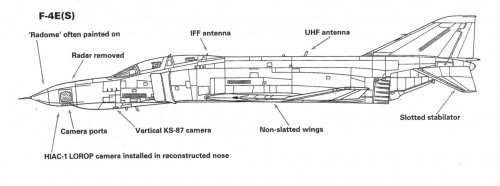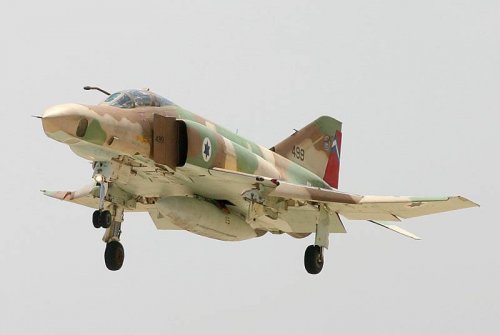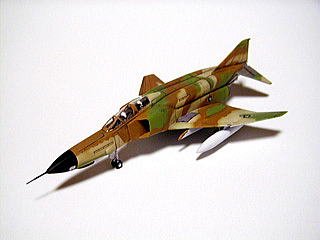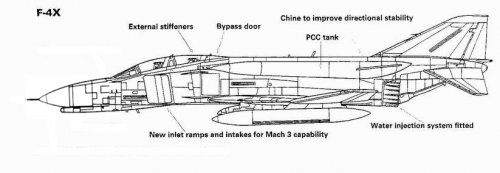I can provide some text (still having problems finding pics):
The F-4X and RF-4X were proposals for advanced F-4E derivatives designed by General Dynamics to carry the HIAC-1 long focal length camera as part of Project Peace Jack. This project was a joint Israel-USAF study for an advanced photo-reconnaissance aircraft capable of Mach 3+ performance.
The HIAC-1 camera was an advanced high-altitude reconnaissance camera that had a focal length of 66 inches which offered unparalled resolution at extreme ranges. The HIAC-1 camera was originally so large and heavy that it could only be carried by the Martin/General Dynamics RB-57F. However, later versions were sufficiently slimmed down so that they could potentially be carried by smaller aircraft such as the F-4 Phantom.
Israel had always wanted the HIAC-1 camera for its own use in keeping track of its Arab neighbors, but its requests had always been turned down. However, in 1971, US attitudes towards export of the HIAC-1 camera changed and approval was given for the development of a pod (designated G-139) which could be carried on the belly of the Phantom. The prototype G-139 pod was over 22 feet long and weighed over 4000 pounds, and was first tested on an RF-4C in October of 1971.
Unfortunately, the G-139 was still so large and bulky that the performance of the Phantom when it was carrying the pod was unacceptably poor. The Peace Jack project originated in an attempt to improve the performance of the Phantom when carrying this camera. Both the USAF and the government of Israel contributed funds for the project.
Rather than trying to slim down the reconnaissance pod, the original goal of the General Dynamics team was to improve the performance of the Phantom that was carrying it. The improved performance was to be obtained by using water injection for pre-compressor cooling, which would provided increased engine thrust at high altitudes. A similar system had been used successfully in the past in various F-4 record attempts. The water was to be contained in a pair of gigantic 2500-gallon tanks which were to be attached conformally to the intersection joints of the fuselage spine and the engine nacelles. The water injection system promised to give a 150 percent increase in engine thrust at altitude. In order to accommodate the increased engine thrust that would now be available, new air intakes had to be designed. The area of the intakes was to be made much larger and they were to contain a sophisticated system of internal cowls, splitter plates, vortex generators and bleeds. With the new intakes and the water injection system, it was anticipated that maximum speeds of up to Mach 3.2 and cruising speeds of up to Mach 2.7 could be attained. The project came to be known as the F-4X, although this was not an official USAF designation.
Israel was clearly very interested in the F-4X, as it promised a a performance which would approach that of the USAF's SR-71. This would enable it to fly unimpeded anywhere it wanted to. However, the advanced performance of the F-4X clearly made it a possible candidate for a new interceptor. Consequently, the US State Department became more than a little worried about the export of such advanced technology overseas, since it promised to give Israel a potential interceptor which was more capable than anything currently in the US arsenal, one which might one day pose a threat to the SR-71. In addition, the Air Force was itself rather nervous about the F-4X project, since it might threaten to divert support away from the F-15 program which was just then getting underway. As a result, the State Department decided to disallow export of this technology to Israel.
This ordinarily would have been the end of the game. However, in the meantime, Israel had expressed concern about the amount of aerodynamic drag produced by the pod carrying the camera. In response to these concerns, General Dynamics decided to relocate the HIAC-1 camera to the nose, displacing the AN/APQ-120 radar. The project was redesignated RF-4X. The removal of the interceptor capability seems to have reassured the State Department, and Israel was once again allowed back into the Peace Jack program.
An ex-IDFAF F-4E (USAF serial 69-7576) was delivered to General Dynamics in December of 1974 to act as a mockup for the RF-4X. The nose was recontoured on the starboard side only, and a paper-mache coolant tank was fitted to one side of the upper fuselage. New intakes with revised variable ramps were fitted. However, in the meantime, the Air Force began to have second thoughts about the project, still fearful of the impact of the RF-4X on the F-15 project and nervous about the safety and reliability of pre-compressor cooling. The USAF withdrew from the project shortly thereafter, forcing Israel to go it alone. By itself, Israel could not afford to continue the project, and the RF-4X program quietly died.
The idea for the nose-mounted HIAC-1 camera was later revived to form the basis of the F-4E(S), which was first applied to F-4E 69-7576.













